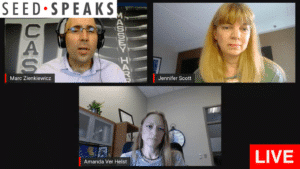
CSTA President
Did you watch the recent Super Bowl? Analysts noted that broadcast ratings were down to their lowest in nine years. Analysts credited modern technology like increased streaming options with diverting some of the attention away from the game. People simply have lots of different options to choose from when it comes to how they watch TV. Time-honoured business models, like live TV paid for through commercials, are no longer as reliable as they once were.
The Seed Synergy green paper can be thought of as the initial design for a new business model meant to carry our industry into the future. It’s the first step in a process aimed toward creating a new field for an entire sector to play on. It’s no small task, and we have to design it to ensure our industry gets stronger in an age where technology is accelerating fast and turning conventional seed sector wisdom on its head. We don’t want our relevance to slip as the world moves at a breakneck pace all around us.
I was privileged to take part in the Guelph Seed Synergy workshop in February. Another five were held across the country. The workshops allowed members to engage in important dialogue concerning the vision laid out in the green paper. This input allowed us to explore the direction we take as we create the white paper that will serve as a roadmap to the future and ensure our business model is strong.
That exploration includes three crucial areas of interest that serve to shake up the foundations of the seed trade: value creation, a universal seed lot system, and a risk-based assessment model.
- Value creation: We need an increased investment in innovation in cereals, but in order to do that we need a system that provides a return on investment. You have to reinvest resources back into the system in order for it to continually move forward. We need a regulatory system that will enable real innovation in seed. That’s the real challenge — to put ourselves in a spot that’s better than where we are today.
- Universal seed lot system: Our members aren’t aligned just yet on this particular proposal, which would see all seed available for commercial sale listed along with at least a declaration of identity and quality. The green paper argues that having a universal system will strengthen and expand traceability — which is today a core of the pedigreed seed system — to all seed sold in Canada. A seed listing system could bring increased transparency and utility to seed sales across the country — and allows for more efficient protections of intellectual property rights and commercial transactions — is what’s needed in Canada, according to the green paper. There’s lots of work to do on that to see what model makes the most sense. I think the goal of our members is to have a system that enables us to make the investments needed to create more value.
Input received from members over the past several months will be factored into what the final white paper has to say on this particular topic, which has created a lot of great conversation. Not everyone agrees that we need this particular kind of seed lot system, but the fact we’re actively having the conversation is important.
- Risk-based assessment model: Creating a next-generation seed regulatory system means developing the right framework to help drive more innovation and have it be based on an understanding of what the risks may be. I think that’s really important and will open up more people to invest in agriculture and drive innovation.
The idea of risk can seem scary for a lot of people, but it’s crucial to emphasize that this in no way means the seed sector faces any more risk today than it ever has. Regulatory approval requirements today are unpredictable, require more information than is necessary to deliver a good outcome, and treat every innovation the same, regardless of risk, as the green paper notes. Today’s system is particularly difficult for smaller businesses to navigate, as they lack the resources required for lengthy and uncertain regulatory processes.
The paper proposes a new risk-based assessment model, that sets regulatory requirements commensurate with the projected risk of new products. Government-sectoral coordination needs to be enhanced to define regulatory standards that make sense.
When our regulatory system is easier or more predictable to work within, we can have more people participate within it and bring new innovation to market so long as our regulations are clear and make sense for everyone.
The next several months will be crucial as we take the input we’ve received and craft the white paper to lay out the Seed Synergy vision. Rest assured the resulting document will map a bold new future for the seed trade that ensures everyone works on a level playing field on which innovation and fair play is the name of the game.












